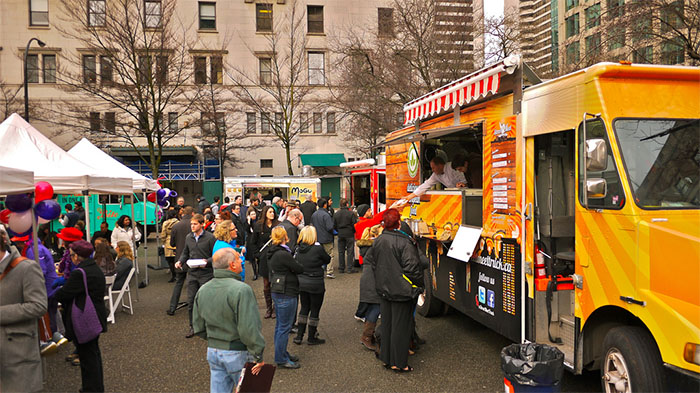The market analysis section of your food truck business plan illustrates your knowledge of the mobile food industry. Here, you present general highlights and conclusions of any marketing research data you’ve collected. The market analysis section should include the following:
Industry description and outlook: In this overview section, include a description of the mobile food industry and the current size of the industry and its growth rate since 2008.

Food truck industry growth since 2008.
Your market analysis section also should include trends and characteristics related to the industry as a whole, and a description of who the major customer groups are within the industry. You can find national mobile food industry growth trends here at Mobile Cuisine.
Target market information: Your target market is simply the group of customers you want to focus selling your food to. When you’re defining your target market, narrow it to a manageable size. Overreaching when making these projections will only hurt you in the long run.
When it comes to target market information, you should gather information that identifies the following for the market analysis section.
Page Contents
Information To Gather
Characteristics of the Primary Market You’re Targeting
- Needs and Fulfillment: Deeply understand the specific cravings, preferences, and dining habits of your potential customers. Are they seeking quick, gourmet options? Are health-conscious choices important to them? Examine how well existing food trucks or local eateries meet these needs.
- Demographics: Collect data on age, gender, income level, occupation, and lifestyle of your target customers. Are they college students, busy professionals, families, or food enthusiasts looking for a novel dining experience?
- Geographic Location: Pinpoint the exact areas where your target market lives, works, or spends leisure time. This could range from urban business districts to college campuses or residential neighborhoods.
- Seasonal Trends: Identify any seasonal patterns affecting food choices, such as a preference for warmer, heartier meals in winter or lighter, cooler options in summer. Consider how events, holidays, or weather changes influence foot traffic and dining preferences.
Size of the Primary Target Market
- Market Size: Estimate the total number of potential customers within your service area. This includes understanding the density of your target demographic in specific locations.
- Purchase Behavior: Gauge the frequency of visits and average spend per visit to similar food trucks or dining establishments. This can help you estimate potential sales volume and revenue.
- Geographic Reach: Define the scope of your service area – is it a specific neighborhood, city-wide, or does it include multiple locations?
- Market Growth: Analyze trends to forecast growth in your target market. Is the population increasing? Are dining habits shifting towards or away from food truck offerings?
- Market Share Goals: Set realistic targets for the market share you aim to capture. This could be based on a percentage of total food truck revenue in your area or a specific number of daily transactions.
- Differentiators: Clearly articulate what sets your food truck apart. This might include unique menu items, superior service, innovative technology for ordering and payment, or sustainability practices.
- Rationale: Provide a well-reasoned basis for your market share projections. Consider your competitive edge, marketing strategy, and any pilot test results or direct customer feedback.
Pricing Strategy
- Pricing Levels: Outline your pricing model and how it compares to competitors. Will you position yourself as a premium option or focus on value?
- Gross Margin: Detail your cost of goods sold (COGS) and target gross margin percentages. This will demonstrate the financial viability of your pricing strategy.

Conduct your own food truck research.
Testing Your Assumptions
Before fully committing to your identified target market, validate your assumptions before you go full steam ahead. You need to prove that the concept and target market you came up with will actually work out that way in the real world.
- Pilot Launch: Start with a soft launch or pop-up events in selected locations to gauge interest from your identified segments.
- Feedback: Collect feedback through direct conversations, feedback forms, or social media to understand what works and what needs adjustment.
- Adjust and Refine: Use the feedback to refine your concept, menu, and marketing strategies to better align with your target market’s preferences.
Identifying whether your assumptions about your target market worked or failed through sales data is a crucial part of evaluating the success or failure of your food truck concept. Setting a clear benchmark, such as achieving 50 sales per day, provides a quantifiable goal to aim for and measure performance against.
The Next Step
Market test results may include, but aren’t limited to, the potential customers you contacted, any information or tastings you gave to prospective customers, and the target market’s desire to purchase your food at varied prices.
- Evaluation of your competition. When you’re doing a competitive analysis for the market analysis section, you need to identify your competition by researching food trucks with similar menus as your own. Food trucks all try to attain the same market segment in each geographic region. Understanding how many trucks navigate the streets of your city is key to your analysis.
After you have this information, assess the strengths and weaknesses of the top food trucks in your area. The next step is to identify any barriers which may hinder you as you enter the market.




